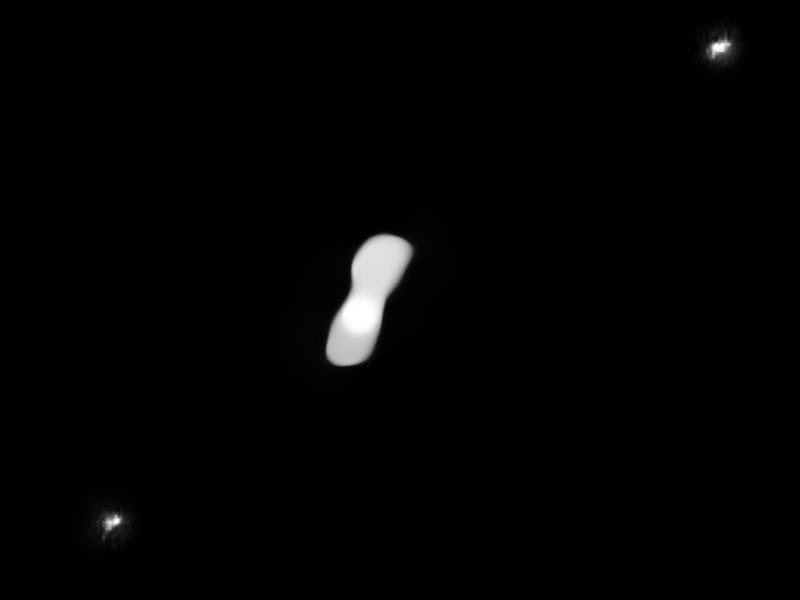Look: A peanut shaped asteroid captured in marvelous detail
Asteroid Kleopatra has two orbiting moons, AlexHelios and CleoSelene.

Flying space objects come in all shapes and sizes, each telling of the origin story behind them.
Astronomers imaged one of the most odd-looking asteroids out there, and the detailed images allowed them to measure the mass and shape of the space rock.
The images were released on Thursday, along with two studies in the journal Astronomy & Astrophysics.
What is asteroid Kleopatra?
Asteroid Kleopatra is named after the famous Egyptian queen and is shaped somewhere between a peanut and a bone. The asteroid has two lobes connected through a thick neck in the middle.
In fact, astronomers have referred to it as a “dog-bone asteroid” since astronomers discovered its odd shape nearly 20 years ago.
Kleopatra is located somewhere between the orbital planes of Mars and Jupiter. It orbits the Sun at a distance of 2.1–3.5 astronomical units and completes one orbit every four years and eight months.
Kleopatra is orbited by two moons, AlexHelios and CleoSelene, named after Queen Cleopatra’s children.
“Kleopatra is truly a unique body in our Solar System,” Franck Marchis, an astronomer at the SETI Institute in Mountain View, California, and the Laboratoire d'Astrophysique de Marseille, France, and lead author of the first study, said in a statement. “Science makes a lot of progress thanks to the study of weird outliers. I think Kleopatra is one of those, and understanding this complex, multiple-asteroid system can help us learn more about our Solar System.”
The high resolution images of Kleopatra reveal the asteroid in great detail.
How was the image of Kleopatra taken?
The team obtained the high-resolution images through the European Southern Observatory’s Very Large Telescope located in the Atacama Desert in Chile. They give astronomers the most detailed look at the asteroid.
Using the recent observations, the team of astronomers behind the two studies was able to measure the mass of the asteroid, as well as its three-dimensional shape. That information can help them figure out how it formed in the first place.
The VLT captured the images at different times between 2017 and 2019, which allowed the telescope to capture Kleopatra as it rotated. As a result, the images show Kleopatra from different angles.
From that, astronomers created a 3D model of asteroid Kleopatra, measuring its exact shape and volume.
Kleopatra measures about 270 kilometers in length, and one of the asteroid’s lobes is larger than the other.
Asteroids with moons
The team behind the second study then used the images to measure the exact orbits of Kleopatra’s moons.
Scientists had previously estimated the moons’ orbits before, but the previous measurements did not match the recent observations.
“This had to be resolved,” Miroslav Brož, a researcher at Charles University in Prague, Czech Republic, and lead author of the second study, said in a statement. “Because if the moons’ orbits were wrong, everything was wrong, including the mass of Kleopatra.”
The newly observed orbits of the moons allowed the scientists to update the estimated mass of Kleopatra, which turned out to be 35 percent lower than previous estimates.
With the updated density for Kleopatra, astronomers now believe that the asteroid formed from material that had been recollected and fused following a giant impact.
The scientists behind the new study also believe they may have figured out how Kleopatra’s two moons formed. The asteroid rotates at high speeds, causing material from its surface to break off and float into space following any impact with another body.
Therefore, scientists believe that AlexHelios and CleoSelene may have been material kicked off Kleopatra by a colliding object. The material was later captured by the asteroid's gravitational pull, which would mean that Kleopatra truly did give birth to its rocky children.
Astronomers will soon point another telescope at Kleopatra to obtain even more detailed images that will likely help them hone in on the asteroid’s origin story. The upcoming Extremely Large Telescope is currently under construction, with no specific date for first light, but it will likely produce even more spectacular views of space objects like Kleopatra.
“I can’t wait to point the ELT at Kleopatra to see if there are more moons and refine their orbits to detect small changes,” Marchis said.